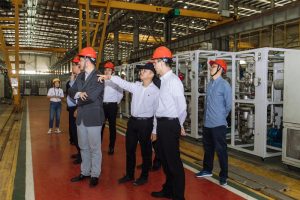What are the common debugging problems in low temperature refrigeration baths?
When the low-temperature cooling bath is in debugging, if the local cooling effect is not good, the system may be blocked by foreign matter or the system design is unreasonable and cannot be adjusted normally. At this time, LNEYA removes foreign matter and thoroughly cleans it to adjust the slope of the pipeline.
When debugging, it is found that the vibration and noise of the pump are large when it is running. It may be that the axial and radial deviation of the coupling is large. It may be that the pump flange is too large and the anchor bolts are unevenly stressed. It is the natural vibration frequency of the pump and the pipeline that cause resonance. At this time, the axial and radial deviation of the coupling are adjusted quickly. Adjust the natural vibration frequency between the pump and the pipe, install the relevant soft joint parts, replace the flange and make the anchor bolts evenly.
During commissioning, it was found that the cooling capacity could not reach the required fixed value. It may be that the cooling tower water temperature did not reach the specified cooling parameter, or the pump output was insufficient, or the condenser isolation gasket was misplaced and could not be cooled, or the pipeline in the condenser was blocked. Repair the cooling tower to meet the water temperature and water requirements, remove foreign matter in the pipeline, and check if the condenser isolation gasket is misaligned.

If the exhaust pressure is too high, it is necessary to pay attention to whether the cooling water is insufficient, whether the condensation in the condenser heat transfer tube is serious, whether the cooling water temperature is too high, whether there is too much air in the system, check the cause, repair the cooling tower, and heat transfer of the condenser. The tube is cleaned to remove air from the system.
If severe frost formation is found, check if the return air filter is clogged, if the exhaust air volume is loose after the fan belt is loose, and if the return air valve is too small, it is recommended to clean the return air filter and adjust the fan belt. Adjust the size of the return air valve.
Common faults encountered in the commissioning of these low-temperature refrigeration baths, we try to check them before debugging, try to avoid these faults.
Verwandte Empfehlungen
-
Arbeitsablauf und Gerätezusammensetzung bei der Ölraffination und Entparaffinierung
1585Der Prozess der Ölentparaffinierung basiert auf dem Schmelzpunktunterschied zwischen dem Wachs und dem Öl, wobei die Löslichkeit des Wachses im Öl mit abnehmender Temperatur abnimmt und das kristalline Wachs durch Abkühlung ausgefällt wird. Dann wird durch t...
Details anzeigen -
Test of working temperature of electric vehicle power battery
1584The normal working temperaturerange of power batteries for electric vehicles is -30 ~ 52 ° C, and the workingtemperature range is -46 ~ 66 ° C, which is difficult to achieve with existingpower batteries. Although local warming measures can be u...
Details anzeigen -
The Structural Characteristics Of Heating Cooling Systems SST-15 SST-20
1558Anyway, Heating Cooling Systems SST-15 SST-20 is a high-performance product with comprehensive functions and simple operation. It will help customers expedite the experiment and save resources so that improve work efficiency.,
Details anzeigen -
Zusammenarbeit mit den Starken! LNEYA&Siemens Unterzeichnungszeremonie der strategischen Zusammenarbeit erfolgreich beendet
3313On May 25, 2021, the signing ceremony of strategic cooperation between LNEYA Constant Temperature Refrigeration Technology Co., Ltd. and Siemens (China) Co., Ltd. was held in Wuxi, China. At the signing ceremony, leaders such as Que Yaoyao, direc...
Details anzeigen
 LNEYA Industriekühler Hersteller Lieferant
LNEYA Industriekühler Hersteller Lieferant











